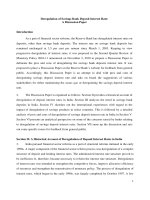THE REFORM OF THE SAVINGS BANK SYSTEM IN FRANCE – A MODEL FOR OTHER COUNTRIES? docx
Bạn đang xem bản rút gọn của tài liệu. Xem và tải ngay bản đầy đủ của tài liệu tại đây (33.36 KB, 6 trang )
THE REFORM OF THE
S
AVINGS BANK SYSTEM IN
FRANCE – A MODEL FOR
OTHER COUNTRIES?
JOCHEN KLEIN*
Up to the end of the twentieth century, the French
banking industry consisted of four distinct groups
of large banks. In addition to the large private
banks comprising Banque Nationale de Paris,
Société Générale and Paribas, which were major
players in the corporate and foreign business, the
government-owned banks Crédit Lyonnais
1
and
Post Office Savings Bank were of considerable
importance for the retail banking. However, the
retail banking was largely dominated by the coop-
erative banks Crédit Agricole, Banques Populaires
and Crédit Mutuel. The fourth mainstay of French
banking was traditionally represented by the sav-
ings banks.
In 2000, the French savings banks entered a new
phase of their development. Following a funda-
mental reform of the law relating to their opera-
tion, they abandoned their traditional legal form
and were converted to cooperatives.
The following article will initially look at the devel-
opment of the savings bank system in France up to
the year 2000 and will then, on this basis, show the
essential aspects of the reform and the resulting
structures of the savings banks institutions. Finally,
it will be asked whether the reform of the French
savings banks institutions may offer an appropriate
model for a reform of their German counterparts.
The development of the savings bank system
in France
From the founding of the first savings bank in 1818
until after the Second World War, the business of
French savings banks (caisses d’épargne et de
prévoyance) consisted solely of collecting the sav-
ings of local citizens in savings accounts and subse-
quently forwarding them to the public authorities
for financing the government. The savings banks
thus assumed the unilateral function of capital col-
lection points for the state.
2
Not until the 1970s did the activities of the savings
banks expand to other bank business. At that time,
they were granted the legal authorization to oper-
ate a lending business and run current accounts
independently, albeit to a limited degree.
The law which reformed the savings banks in 1983
3
finally allowed them to carry out all banking busi-
ness for private individuals, but the corporate
client business continued to be closed to them.
Furthermore, the law annulled the legal form, in
force since 1835 for the savings banks, of charitable
bodies (in private law); they now acquired the legal
form, hitherto unknown in France, of non profit-
making financial institutions. With this step, the
legislators made allowance for the fact that the
savings banks had no profit-seeking shareholders
who had to be paid interest from their annual sur-
plus; rather, their operating result merely had to
ensure the continued existence of the savings
banks.
Numerous mergers then took place between the
savings banks so that they could continue to oper-
ate successfully in the credit business by becoming
large enough to be competitive. Their number
dropped from around 460 to 35 within a mere
decade. Relevant legislation accompanied their
reorganization and in 1991 another reform bill
came onto the law books
4
which adapted their
internal organization to their larger size.
The current structure of the savings bank system
in France
Concerns arose within the French savings bank
group that the uniqueness of the legal form of non-
profit financial institutions granted to the savings
banks by the reform of 1983 could lead to their iso-
lation in the radically changing bank landscape.
These concerns were the principal trigger for the
efforts to give them a “modern” and generally rec-
CESifo DICE Report 1/2003
36
Reform Models
* Dr.Jochen Klein,lic. en droit, is an attorney in Frankfurt am Main
().
1
The privatization of Crédit Lyonnais took place in stages begin-
ning in 1999.
2
See Duet, p. 38 ss.
3
Law no. 83-557 of July 1, 1983 on the reform of the savings banks,
Journal Officiel (JO) of July 2, 1983, p. 2007.
4
Law no. 91-635 of July 10, 1991 modifying law no. 83-557 of July 1,
1983 on reforming the savings banks, JO of July 11, 1991, p. 9023.
CESifo DICE Report 1/2003
37
Reform Models
ognized constitution. This wish of the savings bank
group was satisfied by the reform law of June 25,
1999
5
which converted the savings banks to coop-
eratives with effect from January 1, 2000.
6
As a
result, they have lost the character of an indepen-
dent bank group and now reinforce the coopera-
tive sector, which has consequently gained consid-
erably in importance compared to the private and
public banks.
The legal framework regulating the activities of the
savings banks had previously remained almost
unchanged for 160 years. At the end of the twenti-
eth century, however, the reforms of the years
1983, 1991 and 1999 changed it radically within a
period of only 16 years and gave the savings bank
group a fundamentally new character.
Since the reform of 1999, 34 regional savings banks
and a national bank of the savings banks have been
responsible for running the banking business. The
national bank works together with the regional
savings banks within a closely linked framework
with various responsibilities. The associative tasks
are carried out centrally by a national association
of the savings banks. In addition, the savings bank
group consists of around 450 local savings compa-
nies at its disposal since 1999. These are not
involved in the financial business but are closely
associated with the savings banks in a legal and
practical sense.
The local savings companies
The local savings companies operate under a coop-
erative form of law like the savings banks. They
form the lowest and, in terms of numbers, the
largest unit within the savings bank group in
France. Although not independent institutions,
they are invariably attached to the savings bank in
the region in which they operate. In this way, sev-
eral savings companies are attached to each sav-
ings bank, but with varying numbers in each case.
The savings companies do not conduct any banking
business. Their principal function is to hold all the
shares of the savings banks to which they are
attached. For the law permits only the savings com-
panies to be members of the savings banks. In con-
trast, other interested parties such as the savings
banks clients and employees as well as local
authorities are prohibited from being direct mem-
bers of the savings banks by acquiring their shares.
However, they may acquire shares in the savings
companies, which in turn use all the funds obtained
in this way to obtain shares in the savings banks.As
a result, the importance of a savings companies to
its savings bank is proportional to the volume of its
shares which it invests publicly. Clearly, the more
funds that a savings companies acquires through
the sale of its shares, the more shares it may in turn
draw from its regional savings bank. The local sav-
ings companies thus act as the connecting link
between the savings banks and the numerous (indi-
rect) investors, and relieve the savings banks from
the need to coordinate and support the latter.
The local savings companies have been the target of
considerable criticism since their establishment in
1999. This is directed especially at the fact that their
existence gives the savings bank group an unusual
and clumsy structure compared with the traditional
cooperative banks. For in the latter, the members of
the cooperative participate directly in the banks
without any intermediate agents. As a result, the
avowed aim of the savings bank group to participate
without restrictions in a widely familiar and usual
(cooperative) legal form has not been completely
achieved by the reform of 1999. Moreover, the criti-
cism also attacks the high administrative costs
caused by the existence of numerous savings associ-
ations/companies at local level.
7
Against this back-
ground, it would in principle be a logical step to abol-
ish the local savings companies and transfer their
responsibilities to the savings banks. It remains to be
seen if the keenness of the legislators to undertake
reforms which began two decades ago in the sphere
of savings banks will be sufficiently sustained in the
next few years to carry out this step.
The regional savings banks
The 34 savings banks are large and mutually inde-
pendent regional institutions which have operated
as cooperatives since the beginning of the year
2000. As already outlined, the local savings compa-
nies have the exclusive right to be members of a
regional savings bank, which consequently has a
comparatively small circle of members, averaging
about thirteen.
5
Law no. 99-532 of June 25, 1999 relative to savings and financial
security, JO of June 29, 1999, p. 9487. See also Klein, p. 211 ss.
6
The law granted the banks a period of more than four years to
carry out this conversion, i.e. by the end of 2003.
7
On the criticism levelled against them, see Moster, p. 551.
From the viewpoint of business policy, the reform
law of 1999 eliminated the last hurdle which had
hitherto prevented the savings banks from con-
ducting business with companies listed on the
stock exchange. Regional savings banks can now
carry on all banking business stipulated in the law
on currency and finance
8
, with anyone, without
exception. However, their business continues to
focus on accepting customer deposits into savings
accounts (via a booklet known as livret A) and to
forward them to a public financial institute, the
Caisse des Dépôts et Consignations (CDC)
9
,to
finance the building of subsidised housing. Unlike
the savings accounts run by the other financial
institutions, the livrets A reserved to the savings
banks have the peculiarity that the repayment of
client deposits is traditionally guaranteed by the
state. This guarantee, criticised by the competitors
as competition-distorting, is a major reason for the
enormous popularity of the livret A.
In their business activities, the savings banks must
observe a number of basic principles which have
changed little over the years. Thus they must – in
broad conformity with the regulations applicable
to German savings banks – observe the regional
principle which obliges each bank not to extend its
business activities beyond the region assigned to it
to that of other savings banks. They are also oblig-
ed by law to serve the common good and to per-
form certain public functions. The aim is that they
should have a positive influence on the willingness
of the population to save, on the situation of the
labour market and on the general level of educa-
tion. Moreover, the savings banks should ensure
that no-one is excluded from using the banking and
financial services. Part of their surplus must be
used as a so called “social dividend” to finance
local economic and social projects – for instance in
the domain of environmental protection.
Although the savings banks do perform significant
public functions, the government assumes no liabil-
ity for them – with the exception of the guarantee
for the livret A already mentioned. In particular,
therefore, French savings banks are subject neither
to a liability for the debts of the saving banks
(“Anstaltslast”)
10
nor a guaranty obligation
(“Gewährträgerhaftung”)
11
by the public authori-
ties, which are characteristic of German savings
banks.
The first signs of future change are already appar-
ent for both the regional savings banks and their
local savings companies. Thus concrete indications
already suggest that the number of regional sav-
ings banks will decline further in the near future as
a result of mergers. This is because the business
area of some savings banks is likely to be too lim-
ited for them to achieve satisfactory operating
results in the long term in a tougher and increas-
ingly international competitive climate. It is conse-
quently realistic to assume that the present num-
ber of savings banks, namely 34, will be pruned to
between only 20 and 25 large ones after a further
wave of mergers.
The National Bank of the savings banks
In order to strengthen the savings bank group at
national level by focusing their energies, the
reform law of 1999 created the National Bank of
the savings banks with headquarters in Paris. This
has become the legal successor to two supreme
institutions which had previously exercised the
functions of a central bank as well as acting as the
coordinating body for the savings bank group. In
addition to its activity as a general commercial
bank responsible for key customers, therefore, the
National Bank now acts as the central bank of the
savings banks, administers their liquid funds and
supports their refinancing programs. But it also
possesses extensive representational and monitor-
ing powers as the head of the savings bank group.
Moreover, it administers a guaranty and solidarity
fund which assures the solvency of the savings
banks. The National Bank has the legal form of a
public limited company in which the savings
bankgroup as well as the CDC are majority share-
holders.
The National Association of the savings banks
The National Association, as the second supreme
body of the savings bank group, only came into
CESifo DICE Report 1/2003
38
Reform Models
8
Monetary and financial code, legislative part, annex to adminis-
tration order no. 2000-1223 of December 14, 2000, JO of December
16, 2000.
9
On the traditionally close relations between the savings banks and
the CDC, see Priouret, p. 29 ss.
10
The liability assumed by the public authorities for the debts of
the savings banks obliges these authorities to make appropriate
financial provision to ensure that the banks can perform their func-
tions in a regular manner.
11
The guaranty obligation obliges the public authorities to be
responsible for the liabilities of the savings banks vis-à-vis their
external creditors. For the liability assumed by the public authori-
ties for the debts of the savings banks and their guaranty obligation
in German law, see also Schlierbach/Püttner, p. 138 ss.
CESifo DICE Report 1/2003
39
Reform Models
being on the basis of the 1999 reform law. The
34 savings banks are the sole (mandatory) mem-
bers of the National Association, which was set up
as a registered association, so that it is a body
reserved exclusively to these institutions. The asso-
ciation acts principally as a forum for the exchange
of ideas and the formation of opinions. However, it
also shares the responsibility with the National
Bank of the savings banks vis-à-vis third parties to
represent the common interests of the savings
banks, especially in dealing with the public sector,
and to intensify the links between the savings bank
group and other European savings bank organisa-
tions. As the National Association has limited deci-
sion-making powers, however, it plays only a sub-
ordinate role compared with the National Bank of
the savings banks. Against this background, it
remains to be seen whether the association suc-
ceeds in creating its own profile alongside the pow-
erful National Bank in the long run and in justify-
ing its existence as a second supreme body.
Reflections on a reform of the German savings
bank system on the French model
In various European countries – such as Italy,
Spain and Austria – far-reaching reforms of the
savings banks are currently being discussed for
various reasons. Similarly to the situation prevail-
ing in France, the idea is that radical structural
reforms will enhance the competitiveness of the
savings banks and avoid competitive distortions. In
view of these common objectives, it makes good
sense to determine whether and how far the struc-
ture assigned to the French savings banks by the
reform of 1999 is transferable to these countries
and can act as a model for them.
Comparing the structural features of French and German savings banks
Structural feature France Germany
Proprietor Directly: the local savings
associations. Indirectly: clients,
employees of the savings banks, local
authorities
Local public authorities
Structure of the savings bank
organization
Tripartite (approximately 450 local
savings associations, 34 regional
savings banks, National Bank of the
savings banks)
Tripartite (519 local savings banks,
12 regional state banks,
DekaBankDeutsche Girozentrale)
Coordinating function National Bank of the savings banks State banks and DekaBank
Deutsche Girozentrale
Validity/Application of the regional
principle
Yes Yes
Performance of public functions Yes Yes
Charitable status Yes Yes
Public welfare oriented distribution
of profits
Yes (up to a third of the annual
profits)
Yes (the amount varies in the
individual Federal states)
Liability assumed by the public
sector
No Yes, but in modified form after
July 18, 2005
Guaranty obligation by the local
authorities
No, but state guarantee of “livret-A”
savings
Yes, but to be abolished by
July 18, 2005
Number of retail customers Approximately 26 million
(corresponding to almost 50% of the
population)
Approximately 36 million
(corresponding to about 45% of the
population)
Number of branches
– per million inhabitants
– total
Approximately 87
Approximately 4,700
Approximately 225
Approximately 18,000
Number of employees
– per savings bank (average)
– total
1,235
Approximately 42,000
540
Approximately 280,000
The common points existing in significant domains,
above all as regards the tripartite structure of the
organization, the obligation to observe the regional
principle
12
and to promote public affairs are briefly
contrasted in the table below. Despite all existing dif-
ferences of scale, it would therefore also be conceiv-
able to take the current structure of the French sav-
ings banks in many respects as a model for a future
reform of the German savings bank system.
Indications of an impending radical reform of the
German savings bank system come particularly from
the controversial discussions which have for some
years now centred on certain basic principles of the
German savings bank system operating under public
law. This applies especially to their legal form, the
regional principle, the liability assumed by public
authorities for their debts and the guaranty obliga-
tion. Although some of these discussions have been
initiated and conducted by the savings bank organi-
zation itself, most of them originate from politicians
at state and European level as well as competitors
and banking and legal experts. However, they tend
to be based on the – admittedly variously motivated
– wish to abolish the traditional structural features of
the savings bank system.
The structural debates initiated by the savings
bank organization itself aim to consolidate their
own market position. In contrast, state political cir-
cles often seek ways, in view of the general short-
falls in public funds, to increase the profits of the
savings banks which flow to the local authorities in
order to boost their coffers. There have even been
suggestions to privatize the savings banks in order
to reduce the national debt by means of the rev-
enues released from their sale. Finally, private com-
mercial banks have successfully attempted to abol-
ish the competitive advantages of the savings
banks due to the liability assumed by public
authorities for their debts and the guaranty obliga-
tion. They have been supported by the European
Commission and argue that these arrangements
are incompatible with European subsidy law. The
liability assumed by the public sector and the guar-
anty obligation must now be adapted to the EU’s
subsidy law or be abolished by July 18, 2005.
The various tensions to which the German savings
banks operating under public law are currently
exposed as regards the maintenance of their key
structural features can lead to significant changes
in the mid term.These could, in view of the current
status of discussions, even go so far as to abolish
these savings banks and to privatize them by con-
version into public limited companies, founda-
tions
13
or cooperatives – these legal forms being
most frequently mentioned in the discussions.
In such a case, weighty reasons would support con-
version of the German savings banks into regis-
tered cooperatives on the French model.
German savings banks and cooperative credit insti-
tutions already possess numerous common fea-
tures. Both are integrated into a tripartite financial
association cooperating on the basis of a division
of labour and exhibit a decentralized structure
operating on the regional principle. In addition,
both have a similar customer base consisting large-
ly of private individuals as well as small and mid-
sized businesses.
The German law on cooperatives, which forms the
special legal framework for the activities of the
(registered) cooperatives, represents another fac-
tor of considerable importance for the choice of
legal form: it is distinguished by granting them a
comparatively large discretionary scope, notably
absent from German stock corporation law. In
many respects, it offers the cooperatives the possi-
bility of regulating matters outside the law, in a
manner tailored to their individual needs, in their
statutes. Their members are thus accorded exten-
sive freedom to grant themselves their own legal
constitution within the framework of the autono-
my granted by their statutes as a supplement to the
cooperative law and to structure their cooperative
in accordance with their ideas. Against this back-
ground, the conversion of the German savings
banks into cooperatives would give them the
opportunity to retain a large number of their char-
acteristic peculiarities simply by drawing up their
statutes accordingly.
However, savings banks operating under public
law cannot be converted to cooperatives in
Germany on the basis of the prevailing law. As the
public legal form of the savings banks is anchored
in the state law on these institutions, the legislators
CESifo DICE Report 1/2003
40
Reform Models
12
For the regional principle in savings bank law, see
Stern/Nierhaus, p. 156 ss.
13
To this extent, reference is regularly made to the savings banks in
Austria, Spain and Italy, which are based on the model of a foun-
dation.
CESifo DICE Report 1/2003
41
Reform Models
in the states and – to a lesser degree – the federal
legislators as well, would have to create the legal
basis for such a conversion. In so doing, they could
also make use of the know-how and experience
already gained in France in conjunction with the
reform of 1999 in the following key domains:
– The legal and actual conversion of the savings
banks into cooperatives,
– The use of the revenues accruing from the sale
of the shares of the cooperative savings banks,
– The corporate aim of the cooperative savings
banks,
– The composition of the members of the cooper-
ative savings banks and the future influence of
the local authorities on them,
– The internal organisation and administration of
the cooperative savings banks.
14
Thanks to the existing close business relationships
between them, the French savings banks would
certainly welcome joining their German counter-
parts in cross-border economic exchanges based on
a common – namely a cooperative – legal form.
References
Duet, Daniel: Les Caisses d’Epargne, 4th edition, Paris 1997.
Klein, Jochen: Das Sparkassenwesen in Deutschland und
Frankreich, Berlin 2003.
Moster, Antoine: Sparkassenreform in Frankreich: Die Genos-
senschaft als Rechtsform, in: Sparkasse 1999, p. 549.
Priouret, Roger: La Caisse des Dépôts, Cent cinquante ans d’his-
toire financière, Paris 1966.
Schlierbach, Helmut / Püttner, Günter: Das Sparkassenrecht in der
Bundesrepublik Deutschland, 4th edition, Stuttgart 1998.
Stern, Klaus / Nierhaus, Michael:Das Regionalprinzip im öffentlich-
rechtlichen Sparkassenwesen, Stuttgart 1991.
14
See Klein, p. 376 ss.









